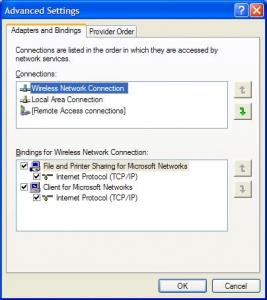Content Type
Profiles
Forums
Events
Everything posted by Ctrl-X
-
How about this: Uninstalling the 2003 or earlier version of Norton Internet Security or Personal Firewall 2003 when Add or Remove Programs does not remove it or this: Removing Norton AntiVirus 2003 or earlier by using the Rnav2003.exe removal utility when Add/Remove programs fails or this: Removing Norton Internet Security or Norton Personal Firewall 2005 from Windows 2000/XP after Add/Remove Programs does not work Hmmm... Looks like Norton has issues with their uninstall procedures Anyway, sounds more like a Norton problem than an XP problem to me!
-
It really depends on the application in question...
-

WINDOWS folder keeps recreating itself in Home Folder
Ctrl-X replied to kcallanan's topic in Windows 2000/2003/NT4
I'm having the exact same problem over here with my own user account: in my home folder, a "WINDOWS" folder is created with a "system" folder inside it. Apart from that the folder is empty. I can delete it without problem, but it keeps coming back... -

RIS - Problem installing NIC and not so unattended!
Ctrl-X replied to burnzdog's topic in Unattended RIS Installation
Allright, I have checked your SIF and found the following errors: Add an extra line to the [Data] section: UnattendedInstall="Yes" (as documented in the Preinstallation Reference) Remove backslash at the beginning of the OemPnpDriversPath (as documented in the Preinstallation Reference) Remove the InstallFilesPath entry (this is only supported in SysPrep.inf) Move the AutomaticUpdates entry to the [Data] section (that's where it's supposed to be) Remove the LegacyNIC entry (this is undocumented in the Preinstallation Reference) You can't use AutoLogon in conjunction with EncryptedAdminPassword (as documented in the Preinstallation Reference) This is exactly why I started by referring you to the guide and the deployment tools. I really urge you to get and read these before you start building an unattended installation, instead of the trial-and-error approach you're using now. -

How to use config for autoinst CD for RIS
Ctrl-X replied to Lolita's topic in Unattended RIS Installation
After you have built the basic RIS CD image, there should be a default RISTNDRD.SIF in the i386\templates folder. You can edit this one or replace it with your own (the name doesn't matter). The $OEM$ folder structure should be next to the i386 folder, not inside it. So in the \\<server>\REMINST\Setup\<language>\Images\<image> folder, you should have a $OEM$ and an i386 folder. -

RIS - Problem installing NIC and not so unattended!
Ctrl-X replied to burnzdog's topic in Unattended RIS Installation
Remove the quotes from the OemPnpDriversPath. Check if the driver folders are actually copied to the correct location. Make sure you use signed drivers where possible. You only need to copy the NIC driver .sys and .inf files (not the .cat files) to the i386 folder. None of the other driver files need to be copied there. -
The setting isn't displayed because the Group Policy console by default only shows "real" policies that can be fully managed. What you are doing is technically not a policy, but a preference. To change this setting right-click the Administrative Templates node, select View / Filtering and uncheck the "Only show policy settings that can be fully managed" setting. To learn more about the difference between policies and preferences, read the Step-by-Step Guide to Understanding the Group Policy Feature Set.
-
Okay, so what't the problem with your custom ADM file then?
-

New to MSFN and need help with OEM unattended Install
Ctrl-X replied to Andycabs's topic in Windows XP
What are the contents of the original WINNT.SIF on the OEM CD? It may say it's just a sample, but there might be something essential in there anyway. -
Tools / Internet Options / Security tab; select applicable security zone (probably "Internet") and click "Default level" under "Security level for this zone". Repeat for other/all zones if necessary.
-

Unattended installation ignoring $OEM$ directory?
Ctrl-X replied to eitheta's topic in Unattended Windows 2000/XP/2003
OemPreinstall should be set to Yes. -
These settings already exist in Group Policy: Computer Configuration / Windows Settings / Security Settings / Local Policies / Security Options; policies "Interactive logon: Message text for users attempting to log on" and "Interactive logon: Message title for users attempting to log on".
-
Google is your friend
-
Not as you describe it, but it should be possible using Group Policy software installation: HOW TO: Use Group Policy to Remotely Install Software in Windows 2000
-
It should be in the Windows Server 2003 installation CD i386 folder, but it will be compressed and therefor be called "REMINST.IN_".
-
This is exactly how we do it: two flat RIS CD images (one Windows 2000 and one XP), replicated to every RIS server, and a generic RIS-only account. Back in 2001 we used DFS replication (NTFRS - the same mechanism that replicates SYSVOL) to replicate our RIS sources, but this didn't always work well... A Microsoft consultant, when asked, told us that NTFRS wasn't really designed to handle the amount of replication traffic we were generating. So we switched to Robocopy "replication" instead. Somewhere along the road (in Windows 2000 SP3, if I remember correctly) Microsoft redesigned NTFRS, but by then we were happy with our Robocopy solution, so we never went back to using NTFRS. But it should be possible; I don't see any reason why SIS should be an issue there. We turned to RIS instead of imaging mainly for ease of maintenance: adding a new driver or another update is a snap. No need for different images for different systems either: all clients install from the same source. Apart from that, what most people don't seem to realize is that you usually need an imaging software license for every computer that receives an image. This would mean we'd need a couple of thousand Ghost licenses, while RIS comes with Windows. Because we need to support a number of languages, we have added several MUI's to our RIS sources. Lately our company has acquired another international company, meaning we will need to support two more languages in the near future. No problem: I just add two extra MUI's to the source and that's all; no need to rebuild images or anything. Another advantage: I need to distribute updates in one language only (English), because that's the underlying language of the Windows source. Nope: SIS came with Windows 2000. But as I pointed out earlier, I don't see why it should be an issue.
-

RIS - Problem installing NIC and not so unattended!
Ctrl-X replied to burnzdog's topic in Unattended RIS Installation
Have you read the Unattended Windows guide yet? Also, go get the Windows XP Deployment Tools. It includes Setup Manager for building unattended installation answer files, and the Preinstallation Reference, which documents all possible answer file settings. -
This question should be in the Microsoft Office subforum. One tip: run a full Office repair.
-
To assign user input to an environment variable, use SET /P. For example: SET /P INPUT=Type some input: ECHO Your input was: %INPUT% Type SET /? in a command prompt window for details.
-
-
Sysinternals is a great source for troubleshooting tools. Especially FileMon, RegMon and Process Explorer are invaluable.
-
If you want to get rid of IE and OE in the Start Menu, add the following to your answer file: [Components] IEAccess=Off OEAccess=Off
-
As the name suggests, they are extensions to the regular commands. When enabled, the behaviour of several commands is affected. Check this article for details. Hope you understand me better now.
-

Help with installation please
Ctrl-X replied to gyrene2083's topic in Unattended Windows 2000/XP/2003
Right; as you may have already discovered, this switch probably only works with a certain kind of installer. The same goes for the /VERYSILENT switch, and so on. What you need to do is find out what switches to use for every application you're trying to install. Fortunately you'll be able to find most of them in the guide: *here* or in the Application Installs subforum: *here*. Exactly. As for the quotations, you'll need to think of it this way: 1. The entire install command, including all switches, needs to be enclosed in double quotes; 2. If the install command itself contains quotes, they need to be preceded by a backslash character. So if the install command is something like... start /wait %SystemDrive%\Install\MyApp\MyINNO.exe /VERYSILENT /SP- /DIR="C:\Program Files\2-Multimedia\MyAppFolder" /GROUP="FolderName" The REG ADD command in RunOnceEx.cmd would be something like... REG ADD %KEY%\005 /V 1 /D "start /wait %SystemDrive%\Install\MyApp\MyINNO.exe /VERYSILENT /SP- /DIR=\"C:\Program Files\2-Multimedia\MyAppFolder\" /GROUP=\"FolderName\"" /f Note the quotes enclosing the install command in green and the ones inside the install command, preceded by backslashes, in red. Because the install command ends in double quotes and the install command also needs to be enclosed in double quotes, in this case the entire string ends in two double quotes. Hope this helps; good luck with it!


